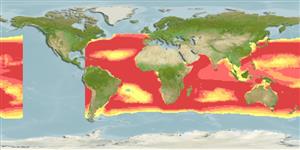Actinopterygii (ray-finned fishes) >
Myctophiformes (Lanternfishes) >
Myctophidae (Lanternfishes) > Lampanyctinae
Etymology: Diaphus: Greek, dis, dia = through + Greek, physa, phyo = to beget, to have as offspring (Ref. 45335).
Environment / Climate / Range
Ecology
Marine; bathypelagic; oceanodromous (Ref. 51243); depth range 0 - 1500 m (Ref. 50610). Deep-water, preferred ?; 50°N - 58°S, 78°W - 153°W
Eastern Atlantic: Western Sahara to Cape of Good Hope, South Africa (Agulhas Water pockets). Western Atlantic: USA to Argentina; between 27°30'N and 35°56'S (Ref. 47377). Northwest Atlantic: Canada (Ref. 5951). Eastern Pacific: Near Hawaii. Western Pacific: 36°N and 1°S southwards to East Australian Current. Western Indian Ocean: west of 70°E between 7°N-25°S, and in Agulhas Current to 37°S. South China Sea (Ref.74511).
Length at first maturity / Size / Weight / Age
Maturity: Lm ?, range 5 - ? cm
Max length : 7.1 cm SL male/unsexed; (Ref. 4479)
Oceanic, found between 375-750 m during the day and nyctoepipelagic at surface down to 125 m (Ref. 4479). Mesopelagic at 0-240 m at night, 315-1500 m during day (Ref. 58302). Seem to reach sexual maturity at a length between 5 and 5.5 cm (Ref. 47377).
Life cycle and mating behavior
Maturity | Reproduction | Spawning | Eggs | Fecundity | Larvae
Hulley, P.A., 1990. Myctophidae. p. 398-467. In J.C. Quero, J.C. Hureau, C. Karrer, A. Post and L. Saldanha (eds.) Check-list of the fishes of the eastern tropical Atlantic (CLOFETA). JNICT, Lisbon; SEI; Paris; and UNESCO, Paris. Vol. 1. (Ref. 4479)
IUCN Red List Status (Ref. 115185)
CITES (Ref. 94142)
Not Evaluated
Threat to humans
Harmless
Human uses
More information
ReferencesAquacultureAquaculture profileStrainsGeneticsAllele frequenciesHeritabilityDiseasesProcessingMass conversion
Tools
Special reports
Download XML
Internet sources
